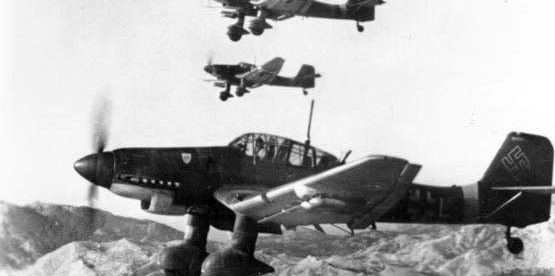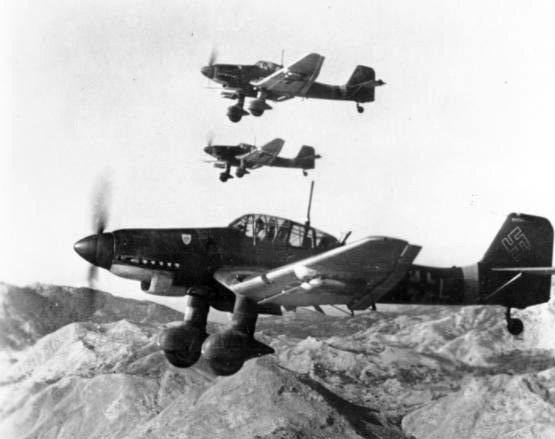The Sound of World War II Planes


If you’ve ever seen a World War II video, you’ve heard the sound of the German bomber planes flying over the sky. But if not, here’s a montage on YouTube. You’ll note, perhaps immediately, that their wails are loud and almost impossible to not notice. And the noise is probably very familiar, even if you didn’t immediately associate it with World War II. In the years since, the sound has been adopted by many movies, cartoons, and the like whenever a plane makes a steep descent. As a result, many think that any time a plane comes hurtling toward the surface, it makes that sound.
That’s not quite right. Very few planes make that sound at all — and none of them have to. Not even the German bomber planes which made the sound famous.
The sound — now known as the Stuka Scream — came from a German warplane called the Junkers Ju 87, seen above. These planes were dive bombers or, in German, “Sturzkampfflugzeug” (hence “Stuka” — the rz kind of fell out). The Ju 87s had a simple job: fly over a target area and dive as close to the ground as possible. Once there, they could release a bunch of bombs with decent accuracy, so that’s exactly what they did. Then, the pilot would pull up and fly away. It wasn’t a foolproof plan — it was almost impossible for a dive bomber to stealthily engage their targets, and the people on the ground below could hear them coming.
But it wasn’t the Stuka Scream that gave them away. The engines were noisy enough to give the planes away, but nothing nearly as loud or menacing as what we’ve come to associate with the planes. Unable to overcome this sound, the Germans decided to turn it into an advantage. In designing the warplanes, German engineers realized that they could equip them with small fans attached to the front of the landing gear. Those fans acted as sirens, making the now-common wailing sound at the planes sped toward the Earth below.
That’s right: there’s nothing about the Ju 87 which’s engine, propellers, or aerodynamics, that requires that it make a Stuka Scream. The siren wasn’t a design flaw at all — it was a feature. The screams from above would, as Wikipedia notes, “weaken enemy morale and enhance the intimidation of dive-bombing.” Basically, when the dive bombers would pass over the enemy line, they’d only be able to strike at a small percentage of it. The sound, however, would spread the terror over a wider distance, giving German forces an extra advantage as they advanced.
After a while, though, the siren’s bark lost its bite. While the bombers were indeed dangerous, troops below learned not to fear them unduly due to their sounds alone. The siren, as one expert explains, came at a cost — “it kept reducing airspeeds by 15 miles-an-hour.” As a result, the Germans removed the sirens from the planes well before the war was over.
Bonus fact: In the Star Wars movies, TIE fighters make a similar sound — you can take a listen here — and that’s probably not a mistake. According to the book The Sounds of Star Wars, the Junkers Ju 87 was the inspiration for the TIE fighters’ galactic screech. (They didn’t take the noise from old WWII movies, as it was apparently too difficult to find a high-quality copy. Per Wikipedia, the sound was created “by combining an elephant call with a car driving on wet pavement.”) But why choose a sound associated with a crash landing? As it turns out, sound designer Ben Burtt knew of the siren’s history. Burtt, per The Sounds of Star Wars, chose the sound because he liked the fact that the Germans had used the sound entirely for intimidation, as he wanted the TIE fighters to do the same thing.
From the Archives: Invisible Pink: Why the British used pink planes in World War II.
